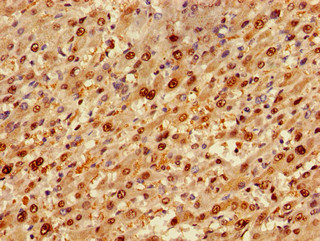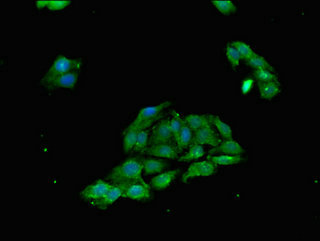
Immunohistochemistry of paraffin-embedded human liver cancer using CSB-PA822174LA01HU at dilution of 1:100
TP53INP1 Antibody

CSB-PA822174LA01HU
ApplicationsImmunoFluorescence, ELISA, ImmunoHistoChemistry
Product group Antibodies
ReactivityHuman
TargetTP53INP1
Overview
- SupplierCusabio
- Product NameTP53INP1 Antibody
- Delivery Days Customer20
- ApplicationsImmunoFluorescence, ELISA, ImmunoHistoChemistry
- CertificationResearch Use Only
- ClonalityPolyclonal
- ConjugateUnconjugated
- Gene ID94241
- Target nameTP53INP1
- Target descriptiontumor protein p53 inducible nuclear protein 1
- Target synonymsp53-dependent damage-inducible nuclear protein 1; p53DINP1; p53-inducible p53DINP1; SIP; stress-induced protein; Teap; TP53DINP1; TP53INP1A; TP53INP1B; tumor protein p53-inducible nuclear protein 1
- HostRabbit
- IsotypeIgG
- Protein IDQ96A56
- Protein NameTumor protein p53-inducible nuclear protein 1
- Scientific DescriptionAntiproliferative and proapoptotic protein involved in cell stress response which acts as a dual regulator of transcription and autophagy. Acts as a positive regulator of autophagy. In response to cellular stress or activation of autophagy, relocates to autophagosomes where it interacts with autophagosome-associated proteins GABARAP, GABARAPL1/L2, MAP1LC3A/B/C and regulates autophagy. Acts as an antioxidant and plays a major role in p53/TP53-driven oxidative stress response. Possesses both a p53/TP53-independent intracellular reactive oxygen species (ROS) regulatory function and a p53/TP53-dependent transcription regulatory function. Positively regulates p53/TP53 and p73/TP73 and stimulates their capacity to induce apoptosis and regulate cell cycle. In response to double-strand DNA breaks, promotes p53/TP53 phosphorylation on \Ser-46\ and subsequent apoptosis. Acts as a tumor suppressor by inducing cell death by an autophagy and caspase-dependent mechanism. Can reduce cell migration by regulating the expression of SPARC.
- ReactivityHuman
- Storage Instruction-20°C or -80°C
- UNSPSC12352203

